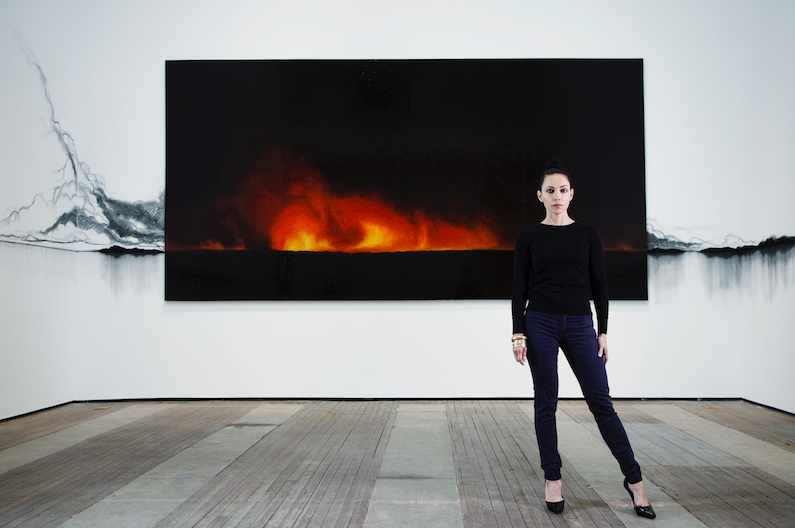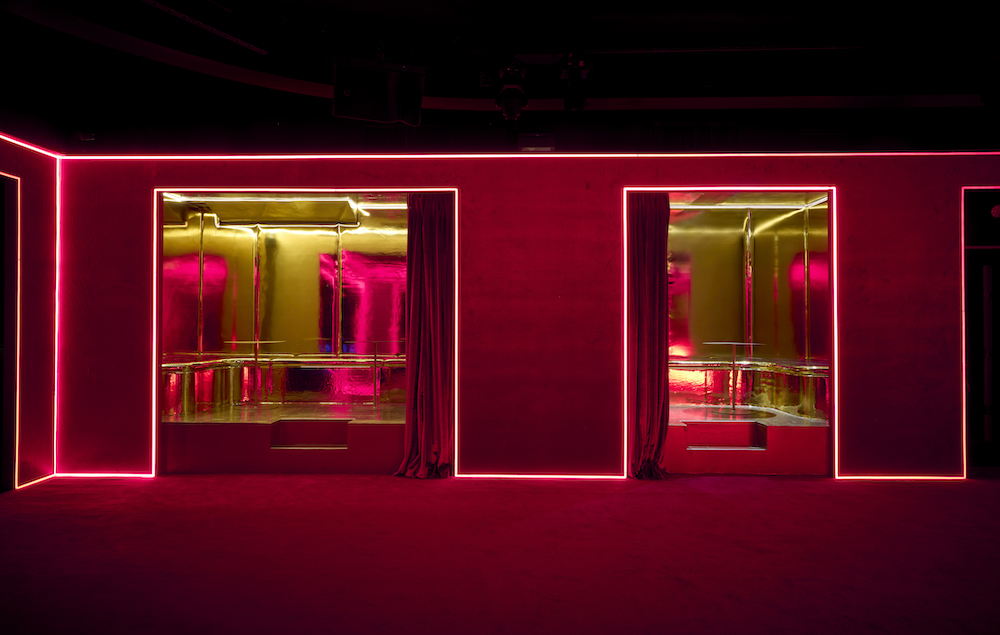Standing in the center of Teresita Fernández’s “Fire (America)” at Lehmann Maupin’s Chrystie Street gallery in New York was an eerie, emotional experience. Flames rose high on the back wall, realized on a large panel of glazed ceramic. A fine horizontal charred trace lined the room. Upon first view, we wondered what had been burned, but speaking with her in late March we learned that’s not Fernández’s point.
“This is a very radical exploration for me of what we think of as landscape,” she said of the exhibition, which was on view from March 17 to May 20, 2017. “Amplifying the idea of landscape to mean more than just a fixed picture, or picturesque image in front of your eyes that you’re outside of, and really understanding landscape as a conceptual phenomenon. This idea that we are actually simultaneously in many landscapes at once.”
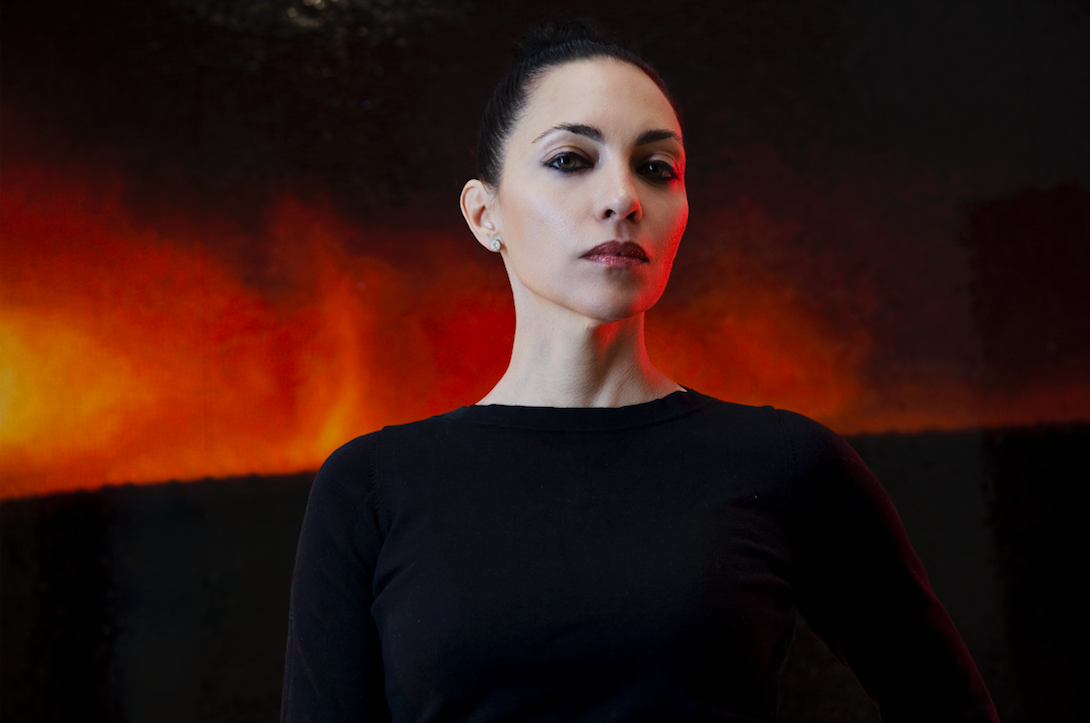
Teresita Fernández.
Portrait by Steve Benisty.
Fernández shared with us her thoughts on the meaning of “landscape,” and the need for more inclusivity of the Latinx community in the arts.
WHITEWALL: Why did you want to explore landscape in this show?
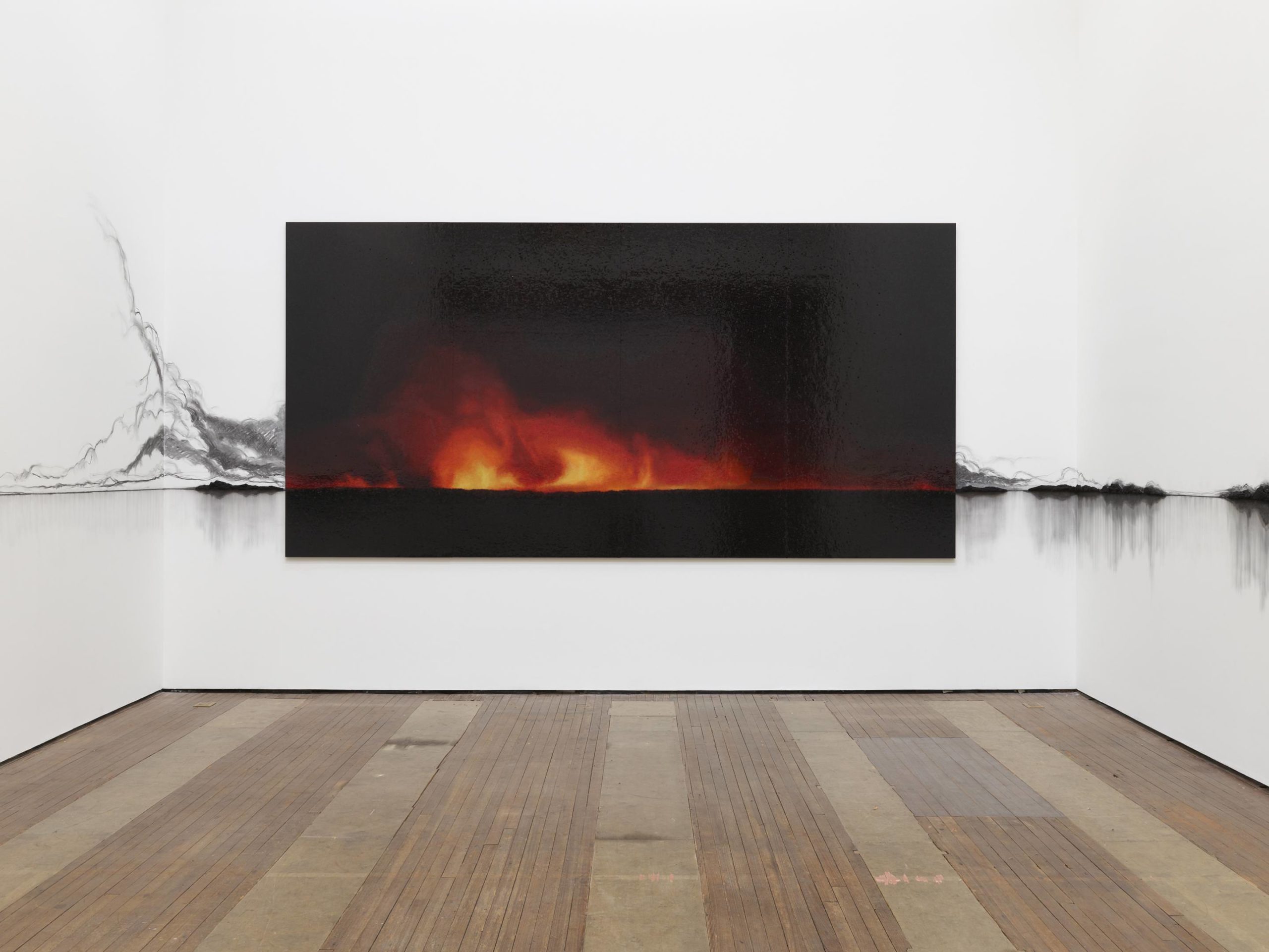
Installation view of Teresita Fernández’s “Fire (America)” at Lehmann Maupin’s Chrystie Street gallery in New York.
Courtesy of the artist and Lehmann Maupin Hong Kong and New York.
TERESITA FERNÁNDEZ: “Landscape” is a very loaded and complex idea, but we mostly tend to associate it exclusively with Western painting traditions. We tend to use the word in a very limited way. If you start to think of landscape more as “place,” and if you start to think of a place as the contradictory history of the people who inhabit it, that’s what I’m interested in. There are all these layers that I’m trying to take apart about how we name and negotiate landscape and how we find ourselves historically and emotionally within a particular physical place.
This installation isn’t a reference to a specific landscape. I wanted to use the gallery space in a very immersive way that surrounds visitors. The installation is many things at once. The glazed ceramic piece on the wall is meant to be a very cinematic reference—the size of it; the glossy, shimmering surface that reflects the space and viewers; the fact that it’s so high up on the wall and has the dimensions of a projection screen. You’re looking at this image and projecting yourself onto it in a way that’s very akin to that imagining that happens within the cinematic context. But then there is also this very tactile, sculptural horizon that comes out of it and engulfs you. You can’t get outside of it, and I think that that’s really crucial to what I’m trying to do, to force you to find yourself within the dynamic—that in order to really understand place, you have to find yourself within it. You have to unravel the history of the place: what has happened there, who has lived there, what kinds of scars are on the land itself, and where do you stand in relation to that.
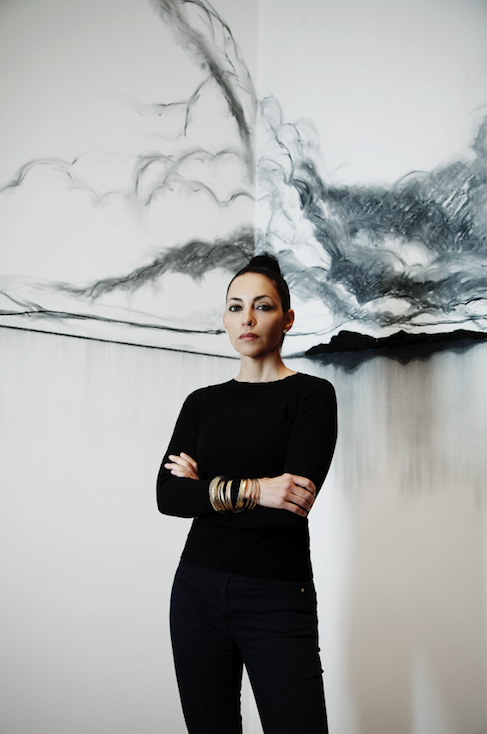
Teresita Fernández.
Portrait by Steve Benisty.
“Landscape art” is also usually thought of as this benign, passive, pretty thing, but in fact every single issue of democracy and social justice that we are grappling with at the moment is so deeply tied to the history of power, the conquest and destruction of land, the claiming of land, the erasure of people’s presence from land, the mapping and redrawing of it that skews our ability to really see a place. In many ways, this show for me dealt with this idea of American violence and American identity and trying to look at the land and the landscape as a vehicle to explore these notions.
WW: What kinds of questions should we be asking about this landscape?
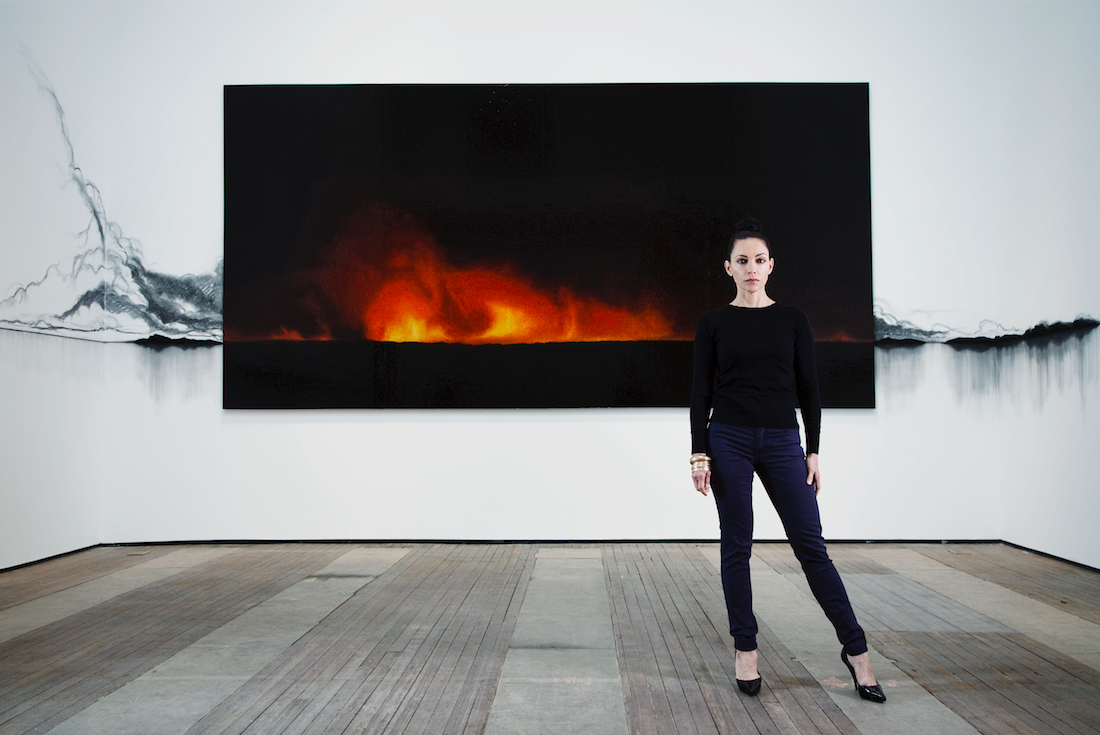
Teresita Fernández.
Portrait by Steve Benisty.
TF: It’s key to understand that things don’t become invisible. Things are very actively erased. In this work I thinking about how at first European contact what we think of today as “The United States” was not an untouched, virgin wilderness, but, rather, a landscape that had been effectively controlled in very sophisticated ways by indigenous people through the use of slash-and-burn techniques that kept the land fertile and healthy. Techniques of burning the land are still used in many parts of the world very effectively. And yet we’ve been taught to think of fire as a bad, destructive thing. In that same way, so much of what gets categorized as “violence” in the U.S. is seen through very manipulated lenses depending on who is telling the story. Images of violence are highly controlled to tell one story, while grossly omitting deeper, more insidious forms of violence that are left out, systemically erasing the intertwined history of power and oppression.
WW: What are you hoping the viewer takes away from this show?

Fire, 2005
silk yarn, steel armature, epoxy
96 x 144 (diameter) inches
243.8 x 365.8 cm
Courtesy of the artist and Lehmann Maupin Hong Kong and New York.
TF: My main focus when I’m making art is, how do I convincingly engage viewers and seduce them to get outside of themselves both emotionally and intellectually? While I’m very rigorous about my extensive conceptual research when planning a work, it’s not really my goal to make that into a narrative or create a didactic piece. It’s much more of a challenge to actually move the viewer and disorient them physically, intellectually, emotionally, psychologically in subtle, intimate ways that mean they also have to give something up. The tools that I am employing in order to engage the viewer have much more to do with beauty, with subtlety, and with provoking the willing viewer’s imagination.
I do not see things in a binary way, as if something can only be beautiful or conceptually rigorous, so I’m very unapologetic about using beauty to touch upon deeper, political issues that are often divorced or pulled out of the pleasure and the effect of being moved by something. I think it’s actually very powerful to get viewers to think about things outside of themselves. In essence, that’s what beauty does—to be able to witness beauty you have to step outside of yourself. It’s a kind of seeing yourself in something that’s not you. For me, if I had to narrow it down to one thing, that’s the essence of what I’m trying to do in my creative practice. Everything else comes after that.
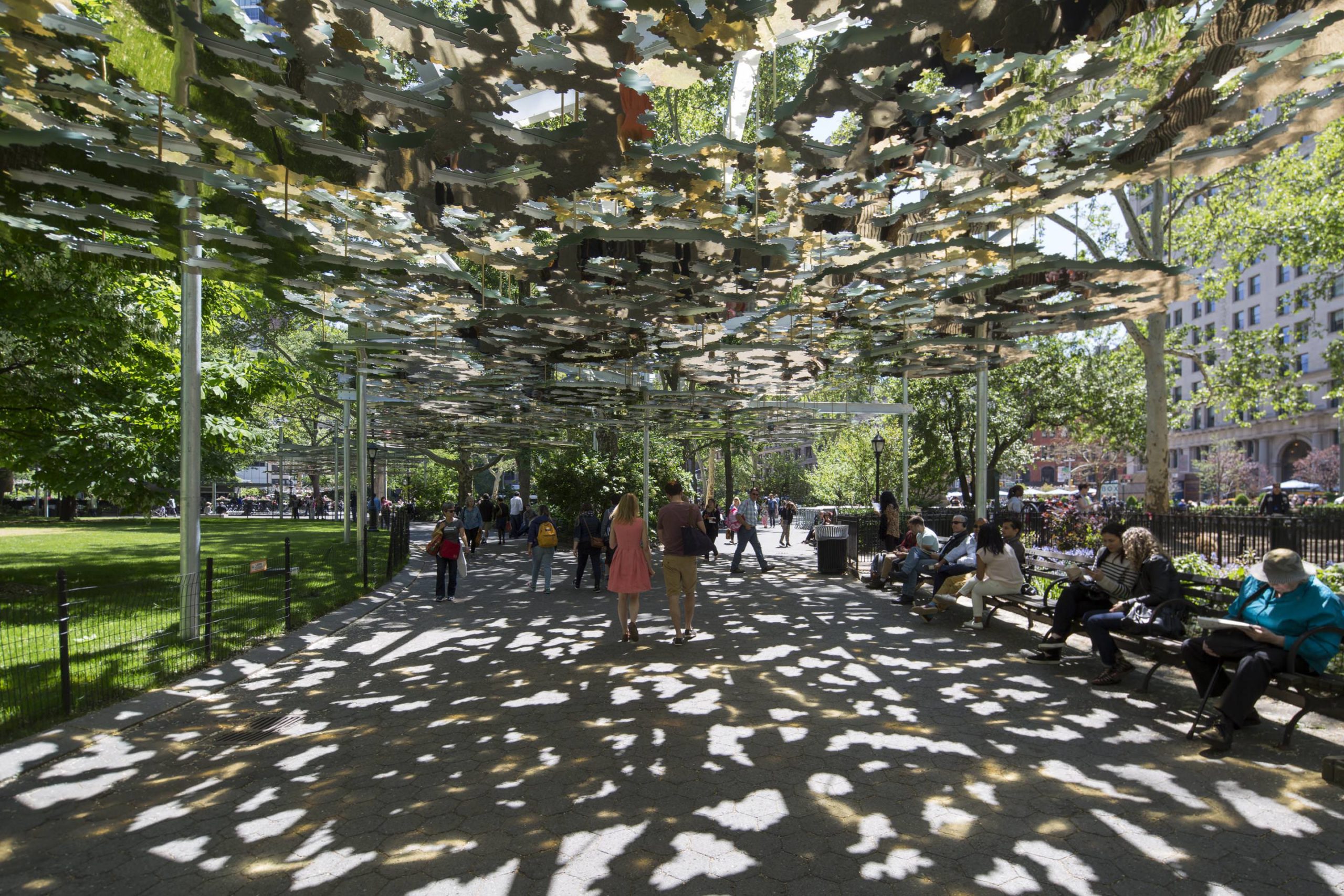
Fata Morgana, 2015
discs: aluminum composite material (ACM)
superstructure: galvanized steel
229 discs
24247 square feet / 2252.62 square meters (approx.)
Courtesy of the artist.
WW: Why did you want to use materials derived from the landscape here?
TF: From a conceptual point of view, there is a kind of material intelligence that is crucial to my work. In this case, the physical, material thing that you’re looking at is always the same thing that I’m also making an image of.

Detail: Viñales (Reclining Nude), 2015
Wakkusu ® Concrete, bronze, malachite
101 x 64 x 48 in
256.5 x 162.5 x 121.9 cm.
Courtesy of the artist and Lehmann Maupin Hong Kong and New York.
For example, this sculptural wall drawing is made from charcoal, which is basically burned wood. It is literally part of a real burned landscape being used to make an image of another burned landscape in this gallery space. The glazed ceramic is made from clay, which is earth and minerals used for glazes that are then fired at a very high temperature. The image you’re seeing of a nocturnal landscape engulfed in flames is materially made with the same process as the image itself. I’m interested in the idea is that you are actually understanding several landscapes simultaneously and that landscape is as much about what you don’t see as what you do see . . . that rendering of something that is not visible then made visible, or something that has been erased present again. And you can apply that idea to all the violence that is constantly erased from our history, too—it’s a way of understanding something by undoing it, and then regenerating and piecing together a new understanding of it. So that the American landscape has to be seen as more than, say, a Frederic Church painting . . . It’s also a mass grave on the border, or contaminated land, or the single biggest Native American protest in history at Standing Rock.
WW: Your work shines for its prominence in the public art sphere, and its large-scale immersive/experiential aspects. Where did this begin?

Viñales (Reclining Nude), 2015
Wakkusu ® Concrete, bronze, malachite
101 x 64 x 48 in
256.5 x 162.5 x 121.9 cm.
Courtesy of the artist and Lehmann Maupin Hong Kong and New York.
TF: That’s a good segue because it really describes how I think of public art—as a space where every individual is its own “public.” I’m interested in the personal, intimate experience with public art. There’s an individuality and pre-political moment where you’re experiencing art very internally, very quietly within the public realm. We have to find ourselves in the art before we can project what we think of it. It’s a very loaded and interesting state. I’m trying to reach each particular viewer in a very quiet way even if the piece takes up an enormous site, like Fata Morgana did at Madison Square Park.
WW: You were appointed by President Barack Obama to serve on the U.S. Commission of Fine Arts. Can you tell us about that experience?
TF: The U.S. Commission of Fine Arts consists of six people appointed to advise Congress and the President on matters of aesthetics and design. We review basically anything outdoors in D.C.—from the National Mall to the museums, monuments, sculptures, surrounding buildings, et cetera. Over those almost four years, I always saw my role as one of those six members, as being about bringing an artist’s point of view to the conversation.
A few years into my appointment, I also realized, almost by accident, that I was the first Latina to ever be appointed to the CFA in its over one-hundred-year history. Ironically, the only other Latino that has ever been on it was Nicolás Arroyo—who happens to have been the last Cuban ambassador to the U.S. before the Cuban Revolution. I’m Cuban-American, so that fact was uncanny to me, but also interesting that nobody had even noticed that it took over a hundred years for a Latina to be appointed. There’s so much erasure that we sometimes don’t even realize exactly the extreme of our invisibility. I love that line in Lynn Nottage’s incredible play Sweat where the Latino character who hasn’t said a word but has been in every scene finally speaks and states how invisible he is to the other characters. The CFA appointment was an honor, but also a great responsibility. We each have power and we each have privilege in different spheres that we move through. Sometimes we walk through one door and we have privilege, and sometimes we walk through another door and we have no privilege. So in that particular context, I felt a responsibility to take the work very seriously, to make the sudden visibility matter.
I was honored to be a part of the pivotal Obama administration, and the way that those eight years that Barack Obama was president really enabled people to imagine the world differently, to see a government that looked like the current demographics of this country.
WW: In September 2016, you partnered with the Ford Foundation to direct the U.S. Latinx Arts Futures Symposium, which brought together leaders in visual arts to discuss how to make arts institutions more vibrant, relevant, and inclusive of the Latinx community. Can you tell us more about that?
TF: I realized at a particular point in my career that the more success I experienced, the less I was seen as a “Latina.” I always felt that there was this unspoken elephant in the room in the attention I received, as though I was quietly always pushed to choose: “You can either be perceived as excellent and successful and assimilate into whiteness,” or “You can be a seen as a Latina.” There never seemed to be a choice that allowed for the complexities of identity. While I’m outspoken and proud of my Latina identity, as a conceptual artist making work about what I think of as universal themes I also had no idea what even constituted “Latina art,” which is also problematic and tends to be full of stereotypes that had absolutely nothing to do with my work. There are virtually no models for being a successful U.S. Latina contemporary artist who is conceptually rigorous and visible (and not dead)—but who could also claim her ethnicity, or not be seen as either/or. Felix Gonzalez-Torres was a dear friend of mine, and I find it appalling that after his death his narrative of being a gay, immigrant, Latino man has slowly been eroded and whitewashed. Ana Mendieta’s work received attention only after her death, and Carmen Herrera had to be a century old to be noticed. Again, the word “responsibility” comes up because I really felt like I had the freedom and agency to spearhead this symposium, and I was secure enough in my career that I could use that privilege effectively. I think that’s the single most important gesture—really saying, “No, you can’t choose between me being this or that.” Identity isn’t a neat package, and I own my own narrative.
The symposium was born of the frustration I felt over people’s confusion between Latin American and U.S. Latino. I was always seen as too American to be “Latin American” but somehow also not American enough to be thought of as an “American artist,” whatever that is. The lack of representation of U.S. Latinos in art institutions, historical collections, programming, museum staffing, and scholarship continues to be a glaring omission. I even found that in most conversations about equity and inclusion in general, U.S. Latinos are rarely included. So I approached Darren Walker, who is the first person to really listen to what I had to say, and said, “This is the largest and fastest growing demographic in the U.S. and we’re virtually invisible in every aspect of the art world.” He asked me to propose something, and I suddenly found myself organizing this symposium from scratch. I had never organized this sort of gathering—my default mode is private and in the studio.
The symposium ended up being an unprecedented gathering of both Latinx artists, scholars and thinkers, and powerful museum leaders in the art world that needed to listen. And those two groups had never really been in the same room together. It was either the invisible Latinos over here in some grassroots context, and the powerful museum people over there trying to figure out how to address “diversity.” It was a convening of museum directors from across the country, curators, demographers, artists, art historians, PhD students, and funders. And to everyone’s credit, people really showed up, and were respectfully invested in one another. The entire symposium was documented and can be seen here: https://latinx-art.tumblr.com/
WW: What responsibilities do artists have for change?
TF: This is nothing new, artists have been doing the work of these conversations for a very long time, but there have been very few institutional changes. Like I said, things are not invisible and silent—things are made to be invisible and silent. There’s a need to confront the deliberate erasure. We in the art world have incredible opportunities to tell these stories, to change that narrative of American identity through the power of art. We have an enormous responsibility to put pressure on museums to collect and exhibit the work of artists who don’t fit the mainstream idea of what an “American” artist is.
If people of color are not represented in museum collections, it becomes virtually impossible to tell the story of American art. As we very rapidly move toward a country made up of majority POC, these are realities that contemporary institutions are all awkwardly grappling with. I think that it’s a shared responsibility—that bloggers and journalists and poets and board members and collectors and gallerists and museum-goers all need to find ways to amplify who and what gets seen.
The truth is, being an artist is hard enough as it is. We need to be able to focus on that creative practice, which is quiet and vulnerable work, and our most powerful tool. But we also need to be seen holistically, not just as creative people, but also as citizens, and as political beings with the power and the ability to make new rules.
This article appears in our Design issue, out now.



